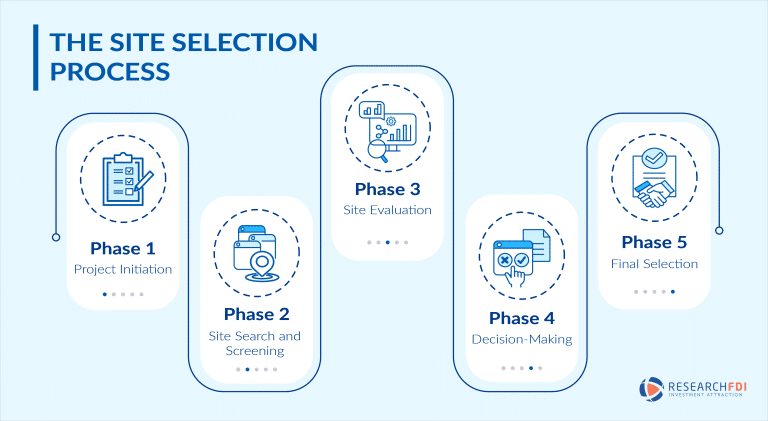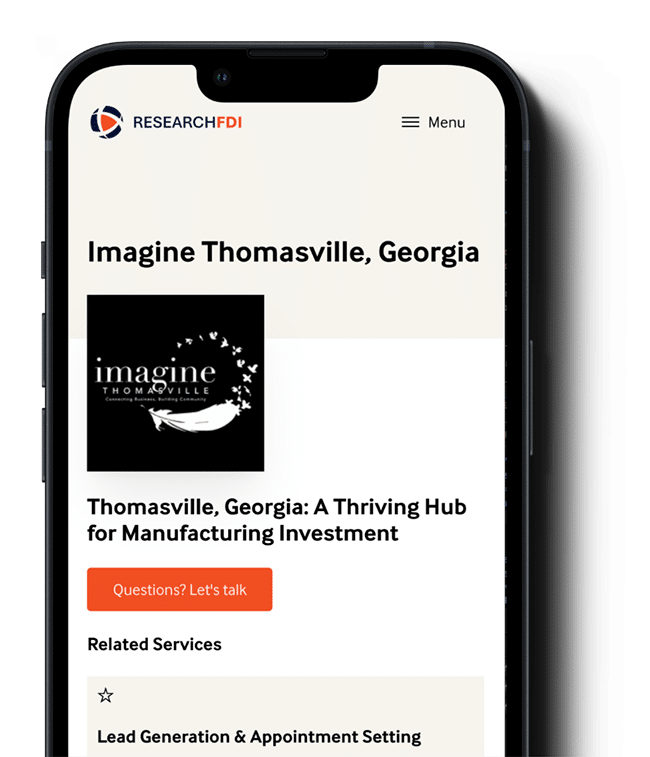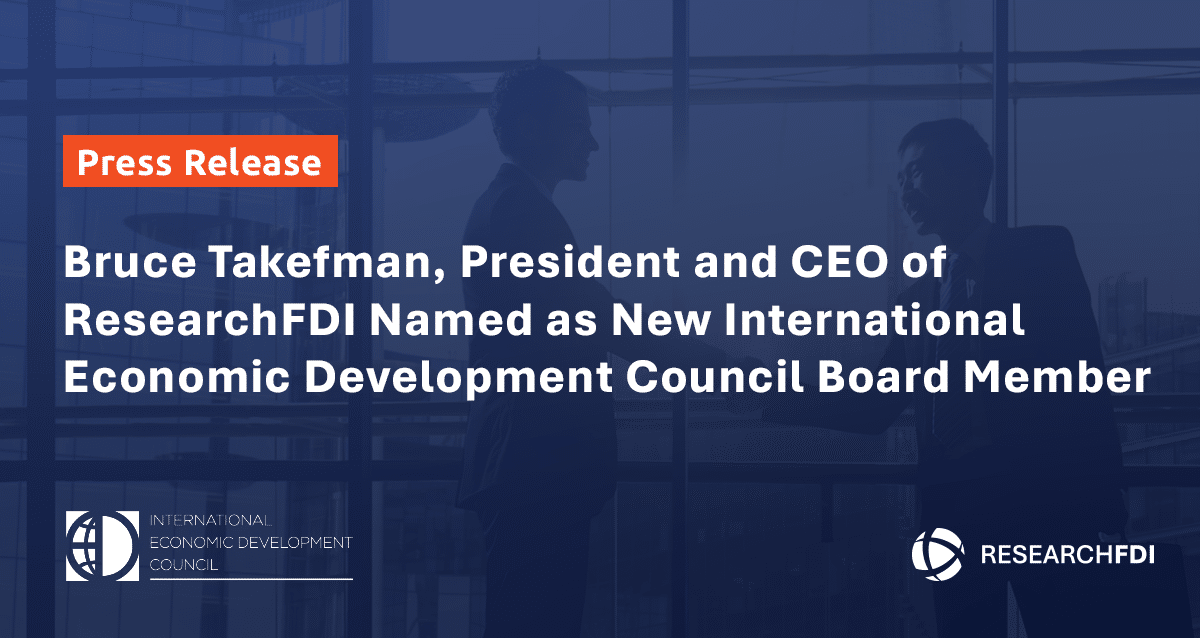As we continue our exploration of the site selection process, we build upon the foundation laid in our previous two parts: Choosing the Perfect Spot: How Site Selection Powers Economic Development and The Power Of Informed Decisions: Site Selection Principles And Best Practices.
The site selection process is a multifaceted journey, comprising several distinct phases, each with its own set of considerations. Understanding these phases is essential for making informed choices and optimizing the chances of a prosperous outcome. In this final part, we examine the site selection process in five distinct phases and discuss best practices as well as crucial factors.
Understanding and Implementing the Site Selection Process
Understanding the site selection process is crucial for any project or development, and while each project is unique, with specific requirements and variables that may lead to slight variations, the site selection process will typically include the same overarching steps and phases.
We have broken down the site selection process into five key phases to reflect the overarching steps that are present in most site selection processes: project initiation, site search and screening, site evaluation, decision-making, and the final selection. Each phase serves a unique purpose and collectively, they provide a structured approach to site selection.
This structured approach ensures that essential aspects such as defining objectives, setting criteria, conducting site evaluations, and making informed decisions are considered in a logical sequence. It also allows for scalability, enabling the process to be tailored to the size, complexity, and industry requirements of the project at hand. The five phases serve as a flexible and adaptable roadmap that you can rely on to guide you through the intricacies of site selection while accommodating the unique needs of each project.

Phase 1: Project Initiation
The Project Initiation Phase is where you set the foundation for your site selection project. This phase consists of assembling your project team and defining your project’s goals, budget, and specific requirements.
Assembling the Project Team:
Assembling a qualified and cohesive project team is crucial to the success of any site selection process. This team might be composed of individuals from different departments including, but not limited to, real estate, logistics, tax, business development, human resources, and the executive team.
Define Project Objectives:
Clarify the purpose and goals of the project. This includes understanding what type of facility or development you need, the budget, and the key requirements.
Phase 2: Site Search and Screening
The Site Search and Screening Phase involves generating a list of potential sites that align with your core criteria. This phase typically consists of three steps, identifying your criteria, conducting preliminary site searches, and conducting preliminary site screenings.
Identify Site Selection Criteria:
Establish a set of criteria that will be used to evaluate potential sites. This can include factors such as location, accessibility, infrastructure, zoning regulations, environmental considerations, and proximity to suppliers or customers.
Conduct a Preliminary Site Search:
Create a list of potential sites that might meet your criteria. This often involves researching available properties, working with real estate agents, and utilizing online databases.
Preform Preliminary Site Screenings:
Screen the potential sites based on your initial criteria, eliminating non-suitable ones and refining the list for more detailed evaluation. This initial screening helps to eliminate sites that clearly do not meet your basic requirements, narrowing down the list of viable options.
Phase 3: Site Evaluation
The Site Evaluation Phase involves on-site assessments and detailed research. This phase includes two key steps, physically visiting and scrutinizing the potential sites, conducting due diligence to uncover any hidden issues and also evaluating the regulatory environment of the site.
Site Visits and Due Diligence:
Conduct site visits for the sites on the shortlist in order to assess their physical condition, suitability for your project, and any potential issues. This due diligence may include researching legal and ownership issues, as well as site history, to uncover potential obstacles.
Environmental and Regulatory Assessments:
Conduct environmental impact assessments and investigate the regulatory requirements for each site to ensure that the selected site complies with environmental regulations and local zoning laws needed for your project.
Phase 4: Decision-Making Phase
The Decision-Making Phase is where you analyze and rank the shortlisted sites. It combines quantitative analysis with qualitative considerations to ensure you are making an informed choice.
Quantitative Analysis:
In this phase, you perform a quantitative analysis of the remaining sites. You might score each site based on your predetermined criteria and weight factors to rank them objectively. This can involve financial modeling, cost projections, and other quantitative tools.
Qualitative Analysis:
In conjunction with the quantitative analysis, you consider qualitative factors. This can include stakeholder input, community acceptance, potential for growth, or any unique advantages or disadvantages that may not be captured by quantitative metrics. This step helps in making a more well-rounded and informed decision.
Phase 5: Final Selection
The concluding phase is all about finalizing site selection, conducting negotiations, and laying the ground for site acquisition. This involves negotiating with property owners and discussing incentives with economic developers and municipal authorities. Once done, the project advances into the planning and development stage.
Negotiations for Real Estate Terms and Purchase Agreement:
Once you’ve chosen the best site, negotiations with property owners or sellers begin. This step involves discussions on price, terms of purchase, and any necessary legal agreements. It’s essential to reach a mutually agreeable deal.
Negotiations for Economic Incentives:
Parallel to discussions with property owners or sellers, negotiations will also be initiated with local, state, and possibly federal leaders for potential economic incentives. These incentives, which may be tax breaks, grants, subsidies, etc., range across various echelons of the government, depending on the project’s scope and scale.
Site Acquisition and Development Planning:
After successfully negotiating and securing the site, you move into the development planning phase. This includes architectural and engineering design, obtaining necessary permits, and laying out the plan for construction and development.
Moving Forward with Site Selection Expertise
The site selection process is more than just a simple matter of picking a spot; it is a strategic tool that can drive economic growth, create jobs, and foster innovation. It shapes the course of community development and has profound socio-economic implications. The choice of location is a pivotal process that underpins economic development and community growth.
This mini-series dived into the complexities and importance of site selection providing comprehensive understanding of the critical process. Through building a foundation of the basics of site selection, recognizing it as a pivotal decision-making process, understanding the guiding principles and best practices, emphasizing the need to prioritize informed decision making and finally breaking down the site selection process into phases, economic developers can better understand site selection as a dynamic and multifaced process. It is an art that requires a deep understanding of its principles and best practices.
By embracing the knowledge shared in this mini-series, economic development professionals and businesses can make well-informed, strategic decisions that drive growth, innovation, and the creation of sustainable, thriving communities. As you embark on your own site selection journey, remember that the choice of location is a powerful driver of success, and every step in the process contributes to the realization of your goals.
More from ResearchFDI:




